Small overlap front: driver-side
Rating applies to 2014-21 models
Tested vehicle: 2016 Toyota Tundra SR5 CrewMax 2wd
The Toyota Tundra CrewMax was redesigned for the 2007 model year. Beginning with 2010 models, the driver and passenger frontal airbags and front seat belts were modified and knee airbags for the driver and front passenger were added. Beginning with 2014 models, the side curtain airbags were lengthened and reprogrammed to deploy in small overlap and moderate overlap frontal crashes to improve occupant protection.
| Evaluation criteria | Rating |
|---|---|
| Structure and safety cage | |
| Driver injury measures | |
| Head/neck | |
| Chest | |
| Hip/thigh | |
| Lower leg/foot | |
| Driver restraints and dummy kinematics | |
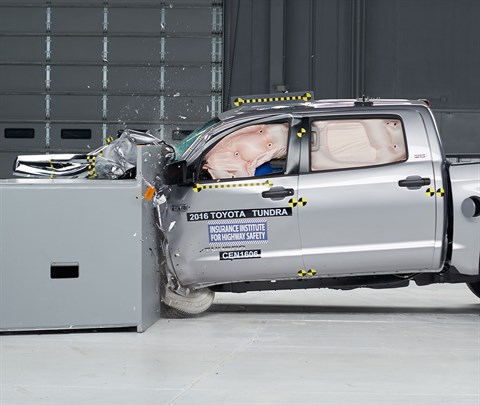
Action shot taken during the driver-side small overlap frontal crash test.
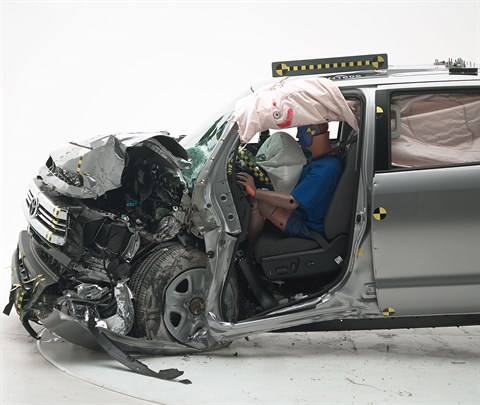
The dummy's position in relation to the door frame, steering wheel, and instrument panel after the crash test indicates that the driver's survival space was not maintained well.
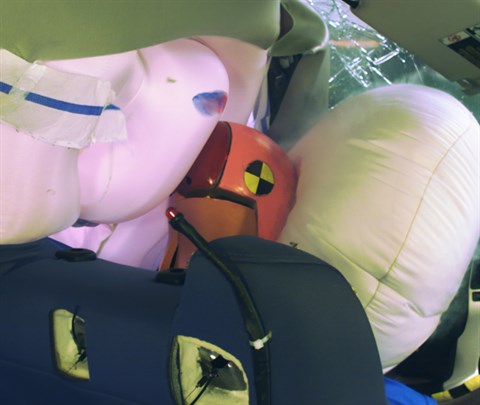
The frontal and side curtain airbags worked well together to keep the head from coming close to any stiff structure or outside objects that could cause injury.
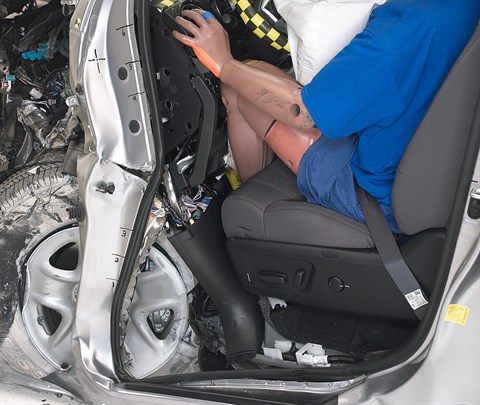
Intrusion of the door hinge pillar, toepan, and instrument panel contributed to a high risk of injury to the left lower leg, a significant risk to the left foot, and a moderate risk to the right lower leg.
Small overlap front: passenger-side
Rating applies to 2014-21 models
Tested vehicle: 2019 Toyota Tundra SR5 CrewMax 2wd
The Toyota Tundra CrewMax was redesigned for the 2007 model year. Beginning with 2010 models, the driver and passenger frontal airbags and front seat belts were modified and knee airbags for the driver and front passenger were added. Beginning with 2014 models, the side curtain airbags were lengthened and reprogrammed to deploy in small overlap and moderate overlap frontal crashes to improve occupant protection.
| Evaluation criteria | Rating |
|---|---|
| Overall evaluation | |
| Structure and safety cage | |
| Passenger injury measures | |
| Head/neck | |
| Chest | |
| Hip/thigh | |
| Lower leg/foot | |
|
Passenger restraints and dummy kinematics
The dummy’s movement was reasonably well controlled. The dummy’s head loaded the frontal airbag, which stayed in front of the dummy until rebound. The side curtain airbag deployed and has sufficient forward coverage to protect the head from contact with typical side structure and outside objects. The side torso airbag also deployed. However, the A-pillar intruded into the passenger space to the extent that the dummy's head hit the attached grab handle during the crash. | |
| Driver injury measures | |
| Head/neck | |
| Chest | |
| Hip/thigh | |
| Lower leg/foot | |
| Driver restraints and dummy kinematics | |
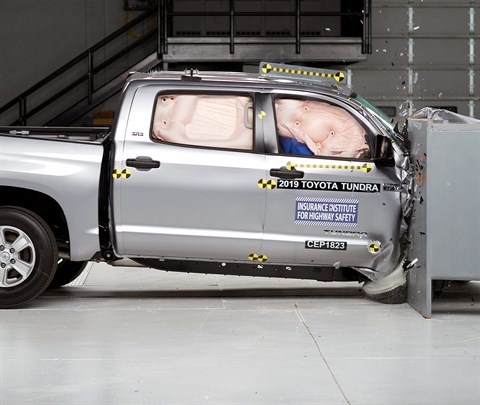
Action shot taken during the passenger-side small overlap frontal crash test.

The dummy's position in relation to the door frame and dashboard after the crash test indicates that the passenger's survival space was not maintained well.
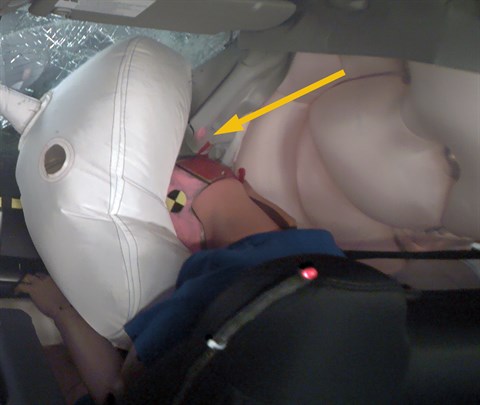
The frontal and side curtain airbags worked reasonably well together, but smeared pink and red greasepaint shows where the dummy's head hit the intruding A-pillar grab handle.
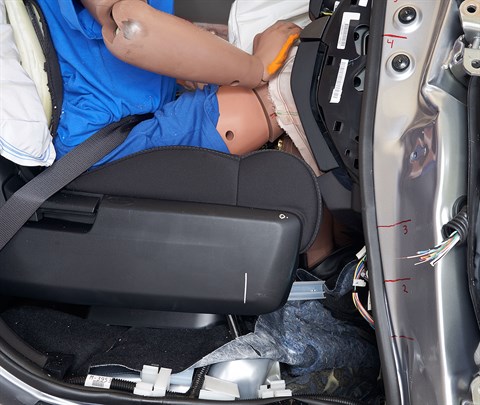
Extensive intrusion of the dashboard, toepan, and door hinge pillar contributed to a likely risk of injury to the right lower leg and a significant risk to the right hip.
Moderate overlap front: original test
Rating applies to 2014-21 models
Tested vehicle: 2016 Toyota Tundra SR5 CrewMax 2wd
The Toyota Tundra CrewMax was redesigned for the 2007 model year. Beginning with 2010 models, the driver and passenger frontal airbags and front seat belts were modified and knee airbags for the driver and front passenger were added. Beginning with 2014 models, the side curtain airbags were lengthened and reprogrammed to deploy in small overlap and moderate overlap frontal crashes to improve occupant protection.
| Evaluation criteria | Rating |
|---|---|
| Overall evaluation | |
| Structure and safety cage | |
| Driver injury measures | |
| Head/neck | |
| Chest | |
| Leg/foot, left | |
| Leg/foot, right | |
| Driver restraints and dummy kinematics | |
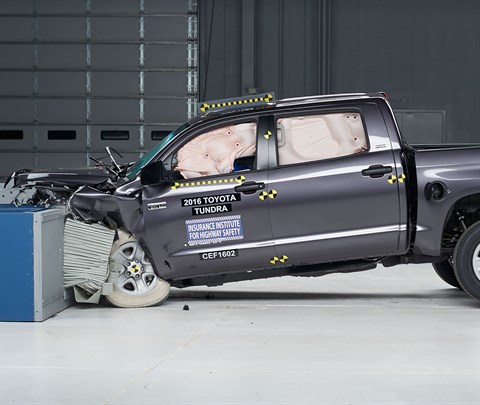
Action shot taken during the moderate overlap frontal crash test.

The dummy's position in relation to the steering wheel and instrument panel after the crash test indicates that the driver's survival space was maintained well.
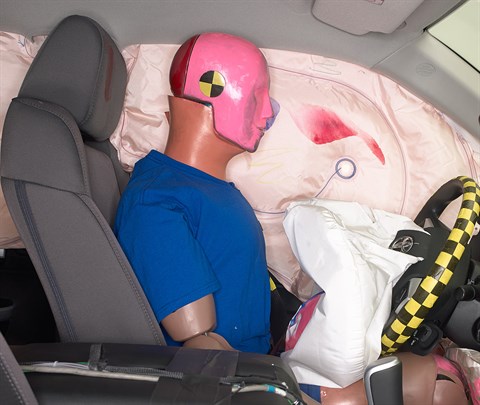
Smeared greasepaint indicates where the dummy's head contacted the side curtain airbag during rebound.
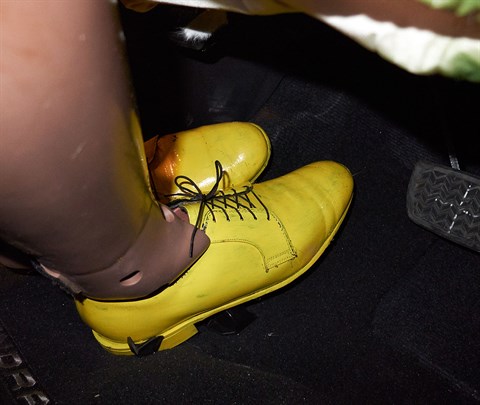
Forces on the right foot were sufficiently high to indicate the possibility of injuries.
Side: original test
Rating applies to 2014-21 models
Tested vehicle: 2016 Toyota Tundra SR5 CrewMax 2wd
The Toyota Tundra CrewMax was redesigned for the 2007 model year. Beginning with 2014 models, the side curtain and side torso airbags as well as the front seat structure were modified to improve occupant protection in side impact crashes.
| Evaluation criteria | Rating |
|---|---|
| Overall evaluation | |
| Structure and safety cage | |
| Driver injury measures | |
| Head/neck | |
| Torso | |
| Pelvis/leg | |
| Driver head protection | |
| Rear passenger injury measures | |
| Head/neck | |
| Torso | |
| Pelvis/leg | |
| Rear passenger head protection | |
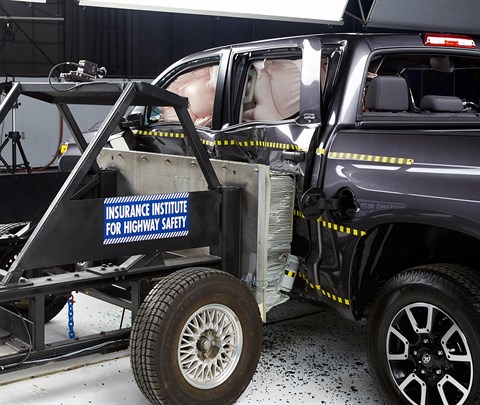
View of the vehicle and barrier just after the crash test.
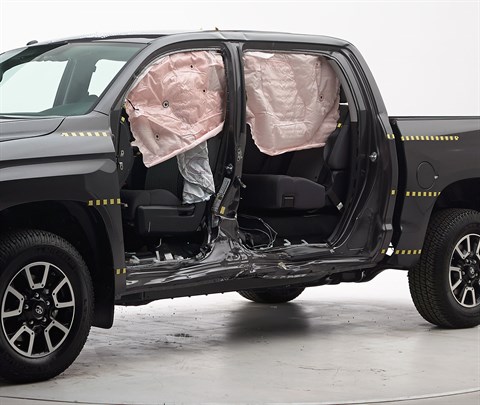
View of the vehicle after the crash with doors removed, showing the side airbags and damage to the occupant compartment.
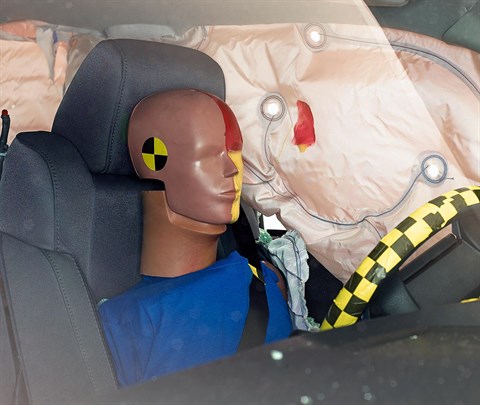
Smeared greasepaint shows where the driver dummy's head was protected from being hit by hard structures by the side curtain airbag.
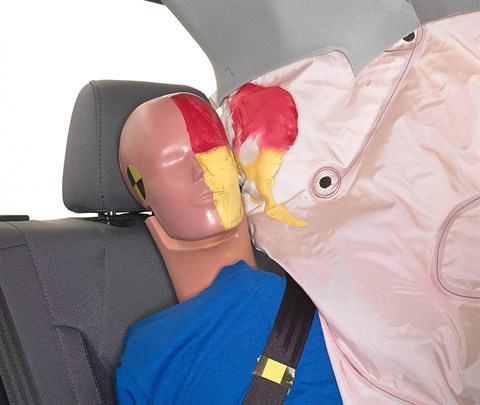
Smeared greasepaint shows where the rear passenger dummy’s head was protected by the side airbag.
Roof strength
Rating applies to 2007-21 models
Tested vehicle: 2016 Toyota Tundra SR5 CrewMax 2wd
| Overall evaluation | |
|---|---|
| Curb weight | 5,432 lbs |
| Peak force | 21,384 lbs |
| Strength-to-weight ratio | 3.94 |
Head restraints & seats
Seat type: Power cloth seat
| Overall evaluation | |
|---|---|
| Dynamic rating | |
| Seat/head restraint geometry |
About the head restraint & seat test
Currently, IIHS tests apply only to front seats.
Headlights
Ratings are given for 2 different headlight variations available on this vehicle.
Trim level(s)
- SR trim
- SR5 trim
| Evaluation criteria | Rating |
|---|---|
| Low-beam headlight type | Halogen reflector |
| High-beam headlight type | Halogen reflector |
| Curve-adaptive? | No |
| High-beam assist? | Yes |
|
Overall rating | |
| Distance at which headlights provide at least 5 lux illumination: | |
Low beams
On the straightaway, visibility was fair on the left side of the road and inadequate on the right side. On curves, visibility was inadequate in all 4 tests.
The low beams created some glare.
High beams
On the straightaway, visibility was good on the right side of the road and inadequate on the left side. On curves, visibility was inadequate in all 4 tests.
High-beam assist compensates for some limitations of this vehicle's low beams on the straightaway and all 4 curves.
Trim level(s)
- SR5 trim equipped with TRD Sport package
- SR5 trim equipped with TRD Off-road package
- Limited trim
- Platinum trim
- 1794 Edition trim
| Evaluation criteria | Rating |
|---|---|
| Low-beam headlight type | LED reflector |
| High-beam headlight type | LED reflector |
| Curve-adaptive? | No |
| High-beam assist? | Yes |
|
Overall rating | |
| Distance at which headlights provide at least 5 lux illumination: | |
Low beams
On the straightaway, visibility was inadequate on both sides of the road. On curves, visibility was inadequate in all 4 tests.
The low beams never exceeded glare limits.
High beams
On the straightaway, visibility was good on both sides of the road. On curves, visibility was inadequate in all 4 tests.
High-beam assist compensates for some limitations of this vehicle's low beams on the straightaway and all 4 curves.
Front crash prevention: vehicle-to-vehicle
Child seat anchors
Rating applies to 2016-21 models built after April 2016
| Evaluation criteria | Rating |
|---|---|
| Overall evaluation | |
| Vehicle trim | SR5 CrewMax |
| Seat type | cloth |
This vehicle has 2 rear seating positions with complete child seat attachment (LATCH) hardware.
It has 1 additional seating position with a tether anchor only.
| Evaluation criteria | Rating |
|---|---|
| Overall evaluation | |
| Vehicle trim | SR5 CrewMax |
| Seat type | cloth |
| Rating icon | Rating |
|---|---|
| G | Good |
| A | Acceptable |
| M | Marginal |
| P | Poor |
| Seating positions that rely on borrowed lower anchors or have only a tether anchor available are not rated. | |
thether anchor symbol | Tether anchor |
lower anchor symbol | Lower anchors |
| Lower anchor(s) can be borrowed from adjacent positions(s) | |
| No hardware available |
Details by seating position
| Position | Rating |
|---|---|
| 1 | |
| Tether anchor | |
| hard-to-find location | |
| no other hardware could be confused for anchor | |
| Lower anchors | |
| not too deep in seat | |
| not too much force needed to attach | |
| easy to maneuver around anchors | |
| 2 | |
| Tether anchor | |
| hard-to-find location | |
| no other hardware could be confused for anchor | |
| Lower anchors | |
| none available | |
| 3 | |
| Tether anchor | |
| hard-to-find location | |
| no other hardware could be confused for anchor | |
| Lower anchors | |
| too deep in seat | |
| not too much force needed to attach | |
| easy to maneuver around anchors |
